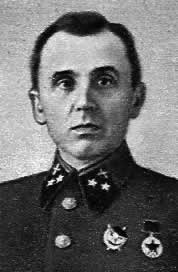| Kirill Semyonovich Moskalenko. | |
|---|---|
 | |
| Born | May 11, 1902 |
| Died | June 17, 1985 (aged 83) |
| Place of birth |
Grishino, Russian Empire (now Ukraine) |
| Place of death |
Moscow, Soviet Union |
| Buried at | Novodevichy Cemetery |
| Allegiance |
|
| Years of service | 1920 – 1962 |
| Rank | Marshal of the Soviet Union |
| Commands held |
38th Army 40th Army Moscow Military District Strategic Missile Troops |
| Battles/wars |
Russian Civil War World War II |
| Awards |
|
| Other work | Commander of Strategic Missile Forces |
Kirill Semyonovich Moskalenko (Ukrainian: Кири́ло Семе́нович Москале́нкo, Russian: Кири́лл Семёнович Москале́нко; May 11, 1902 – June 17, 1985) was a Marshal of the Soviet Union. A member of the Soviet Army who fought in both the Russian Civil War and World War II, he later served as Commander in Chief of Strategic Missile Forces and Inspector General for the Ministry of Defense.
Biography[]
Moskalenko was born in the village of Grishino, near Yuzovka in Russian Empire (today, Hryshyne is part of Donetsk city, Ukraine), in the family of peasants. He attended a number of military academies and joined the Red Army in 1920 and fought on various fronts during the Russian Civil War. During the Soviet-Finnish War, he was the commander of artillery for the 51st Rifle Division.[citation needed]
World War II[]
When Operation Barbarossa began in June 1941, Moskalenko was the commander of an anti-tank brigade. Between June, 1941, and March, 1942, Moskalenko first held command of the 1st Anti-Tank Brigade, 15th Rifle Corps, 6th Army, and later of the 6th Cavalry Corps. He was the commander of the newly reformed 38th Army from March to July, 1942. He was then appointed commander of the 1st Tank Army (July–August 1942) and the 1st Guards Army (August–October 1942) before finally receiving command of the 40th Army, which was separate from the Voronezh Front, a position he held until October, 1943. Moskalenko led his troops during the winter counteroffensive and during the Battle of Kursk. Because of his contributions to a large number of key battles, such as Moscow, Stalingrad, and Kursk, Moskalenko was given the rank of Hero of the Soviet Union. From October 1943 until the end of the war, Moskalenko was the commander of the 38th Army. He led his troops as they helped drive the Germans from the Ukraine, Poland, and Czechoslovakia.
Post-World War II[]
After the war, Moskalenko served in various capacities in the Moscow Military District, before being appointed its Commanding General in 1953. On July 25, 1953, the CPSU Secretary Khrushchev along with Marshals Georgy Zhukov and Kirill Moskalenko staged a coup d'état by secretly arresting First Deputy Prime Minister of the USSR Beria, which was done the next day during a joint CSPU Presidium and Cabinet meeting. While Zhukov could not carry a gun into the Kremlin, Moskalenko sneaked into the Kremlin with a gun to arrest Beria. During the next six months, he and Rudenko investigated the "Beria Case". In December, 1953, the Soviet Supreme Court found Beria guilty after a five-day proceeding. On December 23, Beria was shot. Another version states that Beria was shot by machine gun during the military assault on his residential compound in Moscow.
As a result of this operation, on March 11, 1955, Moskalenko, along with five other commanders, was given the rank of Marshal of the Soviet Union. Moskalenko remained in the Moscow Military District until 1960, when he was made Commander-in-Chief of the Strategic Rocket Forces. In 1962, he was made an Inspector General of the Ministry of Defense. He died on June 17, 1985. His body was buried in Novodevichy Cemetery.
Honours and awards[]
- Twice Hero of the Soviet Union ("Gold Star» № 2002, 23 October 1943 and "Gold Star» № 105, 21 February 1978)
- Seven Orders of Lenin (22 July 1941, 23 October 1943, 6 November 1945, 7 March 1962, 10 May 1972, 21 February 1978, 10 May 1982)
- Order of the October Revolution (22 February 1968)
- Order of the Red Banner, five times (7 April 1940, 27 August 1943, 3 November 1944, 15 November 1950, 28 January 1954)
- Order of Suvorov, 1st class, twice (28 January 1943, 23 May 1943)
- Order of Kutuzov, 1st class, twice (29 May 1944, 25 August 1944)
- Order of Bogdan Khmelnitsky, 1st class (10 January 1944)
- Order of the Patriotic War, 1st class (6 April 1985)
- Order for Service to the Homeland in the Armed Forces of the USSR, 3rd class (30 April 1975)
- Jubilee Medal "XX Years of the Workers' and Peasants' Red Army"
- Hero of the Czechoslovak Socialist Republic (5 October 1969)
- Order of Klement Gottwald
and 28 orders and medals of other countries
External links[]
The original article can be found at Kirill Moskalenko and the edit history here.